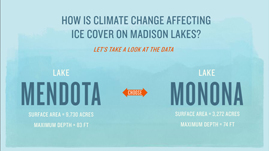Teachers' Domain - Digital Media for the Classroom and Professional Development
User: Preview

Source: Produced by the Wisconsin Educational Communications Board.
This interactive resource produced by the Wisconsin Educational Communications Board explores ice cover data from Lake Mendota and Lake Monona in Madison, WI. The ten longest and shortest ice cover seasons are highlighted in addition to long term trends for both lakes. These data can be compared and analyzed to understand the effects of a changing climate.
Scientists have evidence that climate change is not just something that will happen in the future—it is happening now. Such evidence relies upon accurate records of climate variables dating back well before people thought humans could alter the climate. These records are not common, but the ice cover data for lakes in Madison, WI provide a good example of a valuable dataset for identifying these trends. As University of Wisconsin-Madison lakes researcher John Magnuson says, “We can recall the past and sense change only when we keep records.”
Researchers at the University of Wisconsin-Madison have data recording the formation and melting of ice on Lakes Mendota and Monona in Madison since 1855. The timespan of this record makes it an invaluable resource for documenting the local impacts of long-term climate change.
The records show significant year-to-year variability in the length of the ice-cover season, but there is a clear trend of fewer ice-cover days over time. Overall, the average number of days of ice cover on the Madison lakes has decreased by around 29-35 days over the past 150 years. Significantly, the longest ice seasons on record are all clustered in the first few years of the record, while most of the shortest seasons fall towards the end of the record.
The impacts of reduced ice cover are ecologically significant for lakes and their aquatic species. Ice cover regulates lake temperatures, dissolved oxygen levels, light penetration, and many other ecological parameters that govern growth and reproduction of species and interspecies relationships. Because ice cover reduces wintertime evaporation, it helps to maintain a lake’s water level. A lack of ice cover means that winter winds can make contact with lake waters, disturbing fish nesting sites, and impacting the ways lakes stratify, or form layers of water ordered along a temperature gradient. No ice cover also means no snow cover, allowing sunlight to penetrate the water and increase its temperature. In turn, warmer water temperatures may make the Madison lakes more hospitable to non-native species. For example, University of Wisconsin lakes researcher Jim Kitchell has documented an increase in numbers of sea lampreys, an invasive pest and lake trout parasite, as Lake Superior’s waters warm.
We still need more research to fully understand the ecological impacts of these changes. Aquatic ecosystems are highly complex, and it is not clear what the impacts will be. There is, however, plenty of reason to think that shorter ice cover seasons are having a profound impact on the lakes in Madison, WI.
Here are suggested ways to engage students with this interactive resource and with activities related to this topic.
 Loading Standards
Loading Standards